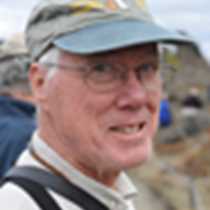On the ice of Svalbard
Ice: water in the solid phase. Being less dense than liquid water, ice floats, and that simple but unusual property so influences our experience here in High Arctic Svalbard. Sea ice forms each autumn as the surface of the ocean freezes. Plates of sea ice congeal until the ice forms a near-continuous cover, broken only by occasional openings where wind and currents prevent it. During the short northern summer the sea ice diminishes; the shrinking ice is broken into discrete floes, gathered and moved by the wind.
In the era of wooden ships powered by the energy of the wind, the ice was feared and avoided whenever possible, but often ice came between men and their objective, be it the hunting of the bowhead whale or the quest to reach the North Pole, and so wooden ships penetrated into the ice. Many were caught and crushed by the immense forces of the Arctic ice, never to return, but the attractions of wealth and glory were too much; the bowhead whale was hunted to the brink of extinction and the North Pole was attained (…or was it? But that is another story…).
Aboard the National Geographic Explorer we seek out the ice and we enter it gladly. Our sturdy ship was made and strengthened for the experience. We look down at tracks over the ice that record the passage of a polar bear, and we gaze out attentively, scanning, searching. The sighting of an all-white ivory gull suggests that polar bear is near, for these birds scavenge on the remains of seals taken by bears. And then, impossibly far in the distance, an ivory-colored fur coat is spotted against the austere white of the ice. Ever so slowly our ship approaches so as not to alarm the one we have come to see. Perhaps he is walking over the ice, perhaps sleeping on an ice hummock, perhaps crouched next to an opening in the ice where a seal might pop up and become the next meal for the polar bear. It is on the ice that the eternal game of predator and prey, polar bear and seal, plays out.
As long as there is Arctic ice the game will continue. It is a better world for this, and so we watch with alarm as satellite data record the diminishing of sea ice in the Arctic. Bears cannot simply change their habits to hunt on land when there is no ice.
We are fortunate to have entered briefly into the realm of the ice bear. We can hope that humans behave in such a way that this interaction continues for future generations to experience as well.




